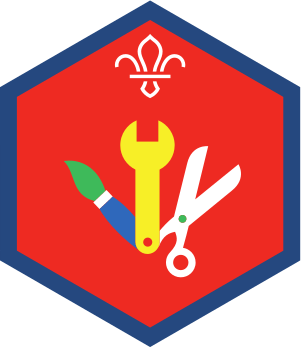Learn how to roll or fold your Scout scarf
You’ll need
- Scarves (such as neckers)
- Woggles
Before you begin
- Use the safety checklist to help you plan and risk assess your activity. Additional help to carry out your risk assessment, including examples can be found here. Don’t forget to make sure all young people and adults involved in the activity know how to take part safely.
- Make sure you’ll have enough adult helpers. You may need some parents and carers to help if you’re short on helpers.
Planning this activity
- Make sure you have a Scout scarf or necker for each person.
- Have a space for people to practice rolling their scarves or neckers on. You could set up a table or find a section of clean floor for everyone to use.
Scout scarves
- Get everyone to gather in a circle.
- Ask if anyone knows any other names for the scarves Scouts wear. Some people call them ‘neckers’. Scouts all over the world wear scarves or neckers, so they remind everyone that they’re part of one big Scout family. In the UK, scarves of different colours show people which group a Scout belongs to.
- Explain that scarves don’t just identify Scouts. They have other uses too. Everyone should take a moment to think about what else a scarf could be used for, and try out some of their ideas. Some ideas include a sling for an injured arm, a blindfold for a game, to tie to luggage to identify it, as a goalpost, to keep the sun off someone’s neck, to clean glasses, to tie hair back, or as a flag.
Roll your scarf
- Open the scarf and put it in front of you with the point facing away from them. Smooth the scarf out, so it’s flat.
- People should start to roll their scarf away from you. Use both hands, and flatten it with your hands as you roll it. This makes sure it stays smooth.
- Keep rolling until the point of the scarf measures the same as your hand span. You can find your hand span by stretching your hand out so it looks a bit like a starfish. When you put their thumb on the roll, your little finger should touch the point of the scarf.
- Put the scarf on, then slide the woggle up over the end to keep it in place.
Fold your scarf
- Explain that some people fold their scarves instead of rolling them.
- To try folding their scarf, everyone should repeat the steps in ‘Roll your scarf’. However, this time they should fold the scarf over about two centimetres at a time, instead of rolling. They should still stop when the point measures about a hand span.
Learn how to tie a friendship knot
Lots of people tie their scarf or necker with a friendship knot.
- Put the right end of the scarf over the left end of the scarf and bring it underneath (so ends up on the right again).
- Fold the right end of the scarf in half and put the very tip underneath the left end of the scarf, leaving a small loop.
- Pull the left end of the scarf down a bit, then take it through the hole your neck goes through.
- Pull the left end of the scarf through the loop you made in step two.
- Gently pull the ends to adjust the knot and make it neat.
Reflection
This activity reminded everyone about how important their scarves are – not just as a symbol of worldwide Scouts, but also as a practical tool. Do some people prefer to roll their scarves while others prefer to fold them? Can anyone remember the Scout motto? It’s ‘Be prepared’. Part of being prepared for Scouts is remembering to bring your scarf to meetings and wear it – it’s also important to take care of your scarf at home and make sure it’s clean so it’s ready to roll or fold.
Safety
All activities must be safely managed. You must complete a thorough risk assessment and take appropriate steps to reduce risk. Use the safety checklist to help you plan and risk assess your activity. Always get approval for the activity, and have suitable supervision and an InTouch process.
Anyone who’s quick can help others. Once everyone’s got the hang of it, why not hold a race to seesaw fast everyone can fold or roll their scarf and put it on (while keeping it neat, of course)?
It’s OK if some people need more support than others. It might be especially tricky for anyone who needs help with fine motor skills.
All Scout activities should be inclusive and accessible.
Learn how to use a scarf as a bandage by bandaging some soft toys. Practise slings and head and limb bandages. You could also learn how to hand wash, rinse and wring your scarf, then hand it out to dry. People could also design their own dream scarves – what colour and pattern would it be?

